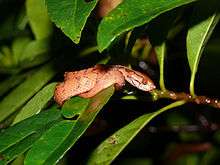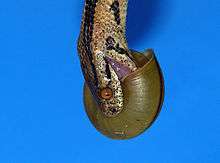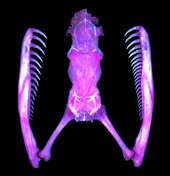Iwasaki's snail-eater
Iwasaki's snail-eater, Pareas iwasakii, is a species of snake in the family Pareidae. The species is endemic to the Yaeyama Islands in the southern Ryukyu Islands, Japan.[2]
| Iwasaki's snail-eater | |
|---|---|
 | |
| Scientific classification | |
| Kingdom: | Animalia |
| Phylum: | Chordata |
| Class: | Reptilia |
| Order: | Squamata |
| Suborder: | Serpentes |
| Family: | Pareidae |
| Genus: | Pareas |
| Species: | P. iwasakii |
| Binomial name | |
| Pareas iwasakii (Maki, 1937) | |
| Synonyms | |
| |
Etymology
The specific name, iwasakii, is in honor of Japanese meteorologist Takuji Iwasaki.[3]
Ecology

Snail-eater in action

Skull of Pareas iwasakii
Pareas iwasakii is a snail-eating specialist;[4] even newly hatched individuals feed on snails.[5] It has asymmetric jaws, which facilitates feeding on snails with dextral (clockwise coiled) shells.[6] A consequence of this asymmetry is that Pareas iwasakii is much less adept at preying on sinistral (counterclockwise coiled) snails.[7]
Taxonomy
Originally described as Amblycephalus formosensis iwasakii by Moichirō Maki,[8] it is currently placed in the genus Pareas.[9]
gollark: Are you Lemmmy?
gollark: That says Lemmmy.
gollark: I wonder if anyone would notice if I put PotatoS on the old CC forums.
gollark: PotatoSPotatOSPoTatosPOTATOSPOTATospotatOS
gollark: Really? You consider random "OS"es better than PotatOS?
References
- Kidera, N. & Ota, H. 2017. Pareas iwasakii. The IUCN Red List of Threatened Species 2017: e.T16220A96877422. https://dx.doi.org/10.2305/IUCN.UK.2017-3.RLTS.T16220A96877422.en. Downloaded on 03 January 2019.
- Pareas iwasakii at the Reptarium.cz Reptile Database
- Beolens B, Watkins M, Grayson M. (2011). The Eponym Dictionary of Reptiles. Baltimore: Johns Hopkins University Press. xiii + 296 pp. ISBN 978-1-4214-0135-5. (Pareas iwasakii, p. 131).
- Hoso, M.; M. Hori (2006). "Identification of molluscan prey from feces of Iwasaki's slug snake, Pareas iwasakii". Herpetological Review. 37: 174–176.
- Hoso, M. (2007). "Oviposition and hatchling diet of a snail-eating snake Pareas iwasakii (Colubridae: Pareatinae)". Current Herpetology. 26: 41–43. doi:10.3105/1345-5834(2007)26[41:OAHDOA]2.0.CO;2.
- Hoso, Masaki; Takahiro Asami; Michio Hori (2007). "Right-handed snakes: convergent evolution of asymmetry for functional specialization". Biology Letters. 3 (2): 169–173. doi:10.1098/rsbl.2006.0600. PMC 2375934. PMID 17307721.
- Hoso, Masaki; Yuichi Kameda; Shu-Ping Wu; Takahiro Asami; Makoto Kato; Michio Hori (2010). "A speciation gene for left-right reversal in snails results in anti-predator adaptation". Nature Communications. 1 (9): 133. doi:10.1038/ncomms1133. PMC 3105295. PMID 21139578.
- Maki, M (1937). "A new subspecies, Amblycephalus formosensis iwasakii, belonging to Amblycephalidae Ishigaki-jima". Trans. Nat. Hist. Soc. Formosa. 27: 217–218.
- Ota, Hidetoshi; Jun-Tsong Lin; Toru Hirata; Szu-Lung Chen (1997). "Systematic review of colubrid snakes of the genus Pareas in the East Asian islands". Journal of Herpetology. 31 (1): 79–87. doi:10.2307/1565332. JSTOR 1565332.
Further reading
- Hoso, Masaki; Hori, Michio (2008). "Divergent Shell Shape as an Antipredator Adaptation in Tropical Land Snails". American Naturalist. 172 (5): 726–32. doi:10.1086/591681. PMID 18834301..
This article is issued from Wikipedia. The text is licensed under Creative Commons - Attribution - Sharealike. Additional terms may apply for the media files.
